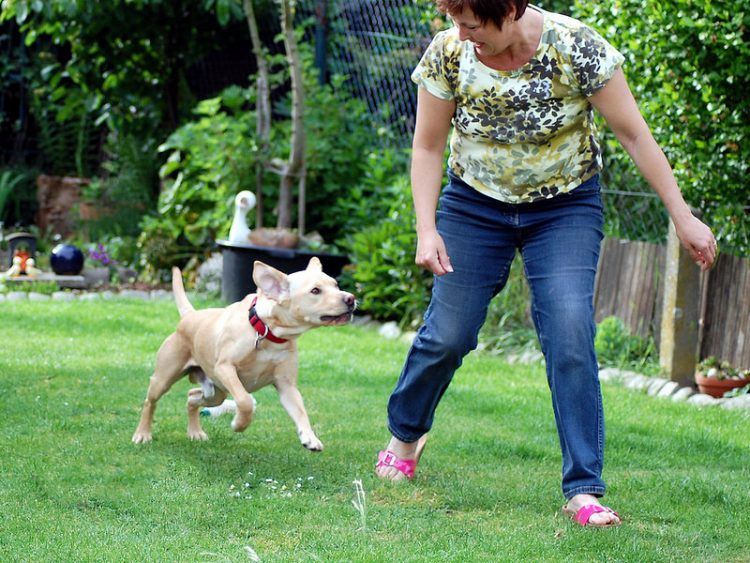
Just like sunburn, some health problems are seasonal.
Indeed, it’s that time of year when I become extra cautious while seeing a dog with an itchy ear and take care to check for grass awns trapped deep within the ear canal.
This year has not disappointed with the usual crop of grass awns embedded between toes or stuck in ears. Let’s take a look at 3 dog-related grass issues, what they mean and how to prevent them.
1. Lawn Burn
Right after we got a puppy, mysterious brown patches appeared in our lawn. No surprise that the 2 things are linked.
Now our backyard grass is distinctly patchy where Poggle pees, so why is this and what can be done?
Grass Burn Trivia
- Female dogs are more likely to cause grass burn — they squat and void their bladder in one horizontal spot, whereas males often sprinkle sideways on plants.
- The bigger the puddle, the greater the burn. Thus large dogs or those kept inside for long periods are the worst offenders. I guess this makes the biggest culprit a female Great Dane who’s only let out twice a day.
Those brown patches are in fact caused by nitrogen scorching. Factors that influence how much nitrogen is in the pee are:
- Diet: Protein coming in at one end produces nitrogen out at the other. Puppy food is higher in protein than adult food.
- Urine concentration: The more concentrated the urine (i.e., the less the dog drinks or the longer she holds on) the greater the amount of nitrogen produced.
It’s true that nitrogen is a natural fertilizer, but in the case of dog pee, it’s too much of a good thing.
What Is the Solution?
For the lawn-proud gardeners out there, here’s what can be done:
- Water in: Provide a pet fountain so the dog drinks more and produces diluter urine.
- Water out: Each time the dog pees, dilute the puddle with water from a watering can.
- Diet change: Look for a food that provides calories from fat and carbohydrate rather than protein.
- Seed change: Reseed the lawn with more hardy species, such as fescues or rye grass.
- Training: Teach your dog to toilet in an out-of-the-way spot where the damage won’t show.
- Finally, be wary of some “anti-scorch” food supplements. Those that contain methionine work by acidifying the urine, which in some dogs increases their risk of bladder stone formation.

2. Grass Eating
Most people are familiar with their dog chowing down on grass, but why do they do this?
No one is 100% certain, but the most likely explanation goes back to the wild origins of dogs. Back then, when a dog made a kill, he ate all of the prey, including the gut and the plant material it contained, thus giving the dog a balanced diet.
In the modern day, our pets retain that instinct to take in vegetation and may eat grass partly out of habit and partly out of some deep-seeded programming to take in extra roughage.
Eating grass can make dogs vomit. Again, it’s likely that dogs associate having stomachache with the relief given when they cleanse their system by vomiting. Dogs understand on a primitive level that the tickle of grass in their throat or stomach makes them sick.
Grass is perfectly fine for your pet to eat as long as it isn’t coated in pesticides or herbicides. However, the exception is swallowing long grass — sometimes this can knot up in the stomach and cause a blockage.
Even if dogs are fed a balanced diet, they’ll still eat grass, apparently:

3. Foreign Bodies
Dogs who run through long grasses are magnets for grass awns. Shaped like mini-darts, they worm their way into a dog’s coat or ears. The sharp point of the awn can pierce the skin, and the seed then migrates beneath the skin’s surface, causing infection, swelling and discomfort.
The 2 most common places for a grass awn to lodge are:
- Between the toes, in what is called an interdigital cyst
- In the ear canal
With a longhaired breed, everyone should check his or her dog’s paws and ears after each walk. Spotting that awn while it’s still on the surface and removing it will save your dog a lot of discomfort (and a large vet bill).
For drop-eared dogs such as spaniels, consider clipping the fur short on their earflaps for the summer months so there’s less hair concealing those pesky grass seeds.
So there we have it — some interesting info about dogs and grass. What are your experiences with dog-related grass issues (or grass-related dog issues)?
This pet health content was written by a veterinarian, Dr. Pippa Elliott, BVMS, MRCVS. It was last reviewed Oct. 11, 2018.



